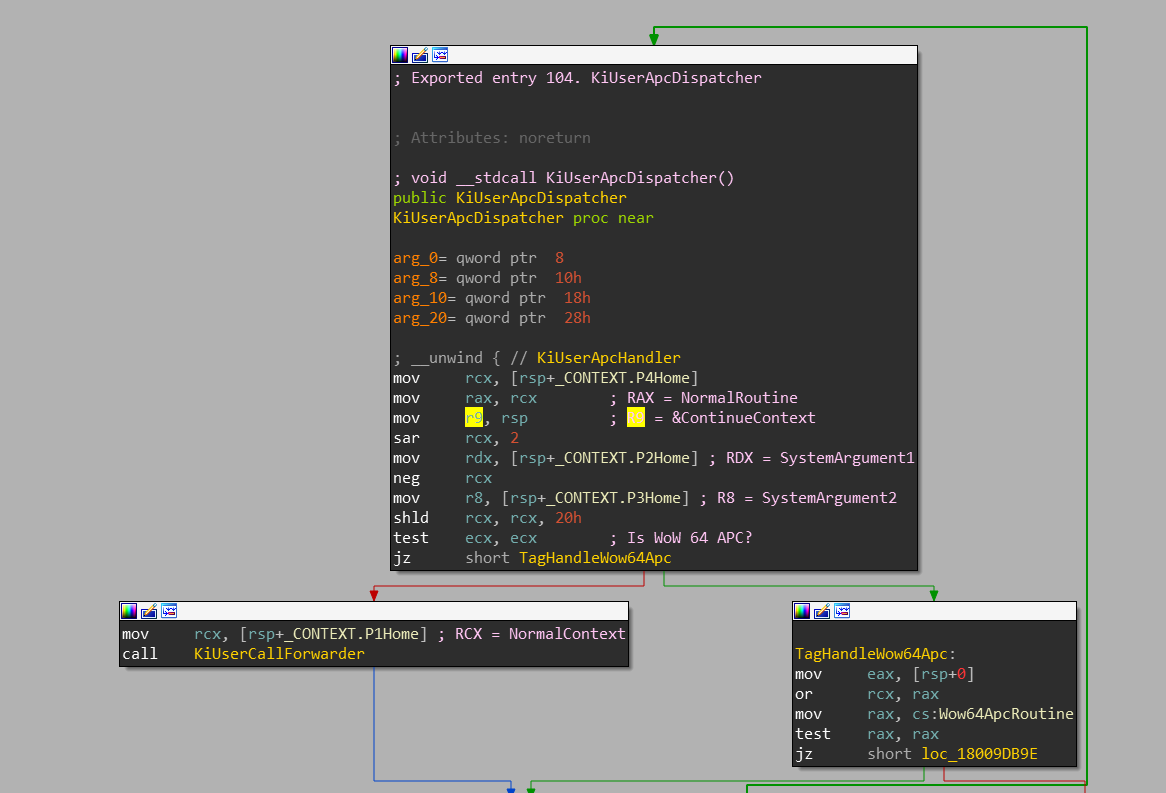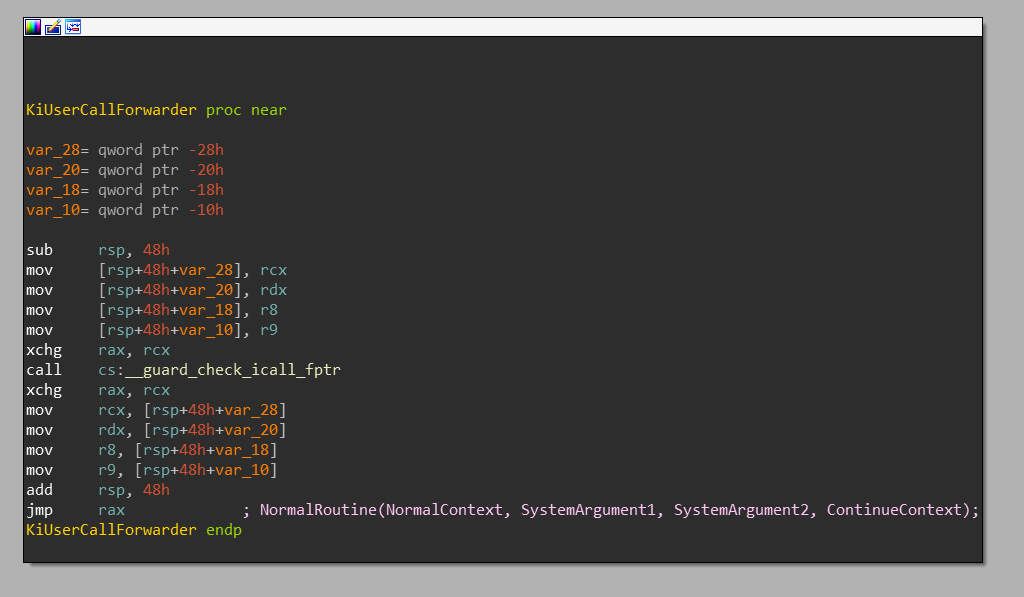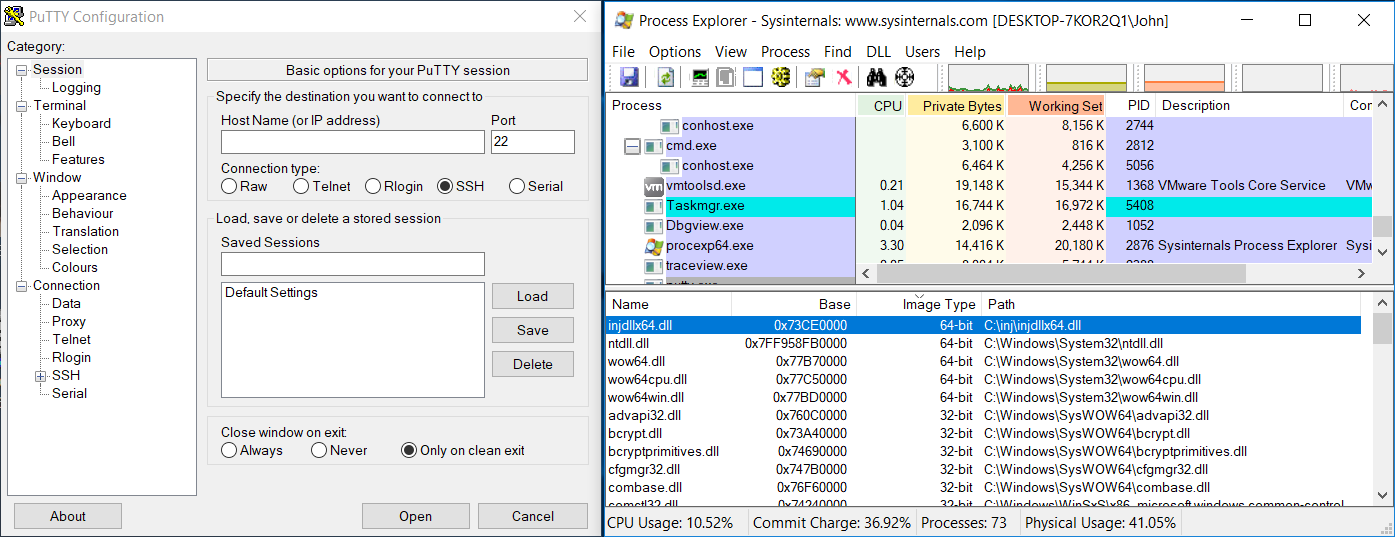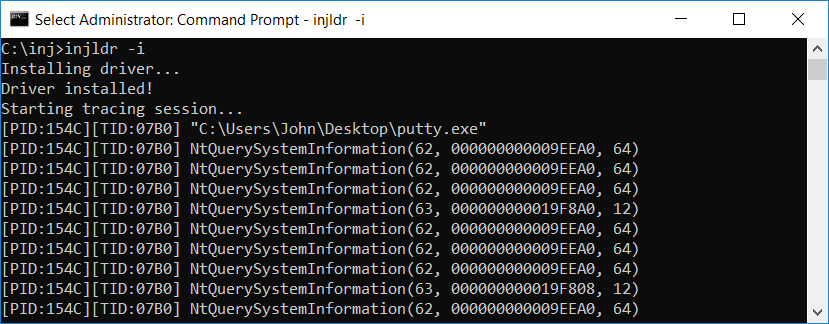injdrv is a proof-of-concept Windows Driver for injecting DLL into user-mode processes using APC.
Even though APCs are undocumented to decent extent, the technique of using them to inject a DLL into a user-mode process is not new and has been talked through many times. Such APC can be queued from regular user-mode process (seen in Cuckoo) as well as from kernel-mode driver (seen in Blackbone).
Despite its popularity, finding small, easy-to-understand and actually working projects demonstrating usage of this technique isn't very easy. This project tries to fill this gap.
- Support for Windows 7 up to Windows 10
- Support for x86, x64, ARM32 & ARM64 architectures
- Ability to inject Wow64 processes
- With DLL of the same architecture as the injected process (e.g. x86 DLL into x86 Wow64 process)
- With DLL of the same architecture as the OS (e.g. x64 DLL into Wow64 process on Windows x64)
- DLL is injected in very early process initialization stage
- Injection is performed from the
PsSetLoadImageNotifyRoutinecallback - Native processes (e.g. x86 on Windows x86, x64 on Windows x64, ...) are injected on next load of DLL after
ntdll.dll - Wow64 processes are injected on next load of DLL after the Wow64-DLLs are loaded
- Injection is performed from the
- Because of that, injected DLL must depend only on
ntdll.dll - Demonstrative DLL performs hooking of few
ntdll.dllfunctions- Achieved using DetoursNT
- Detoured functions use
ETWto trace hooked function calls
Because DetoursNT project is attached as a git submodule, which itself carries the Detours git submodule, you must not forget to fetch them:
git clone --recurse-submodules git@github.com:wbenny/injdrv.git
After that, compile this project using Visual Studio 2017. Solution file is included. The only required dependency is WDK.
When the driver is loaded, it'll register two callbacks:
- For process create/exit notification (
PsSetCreateProcessNotifyRoutineEx) - For image load notification (
PsSetLoadImageNotifyRoutine)
When a new process is created, the driver allocates small structure, which will hold information relevant to the process injection, such as:
- Which DLLs are already loaded in the process
- Addresses of important functions (such as
LdrLoadDllinntdll.dll)
Start of a new Windows process is followed by mapping ntdll.dll into its address space and then ongoing load of DLLs
from the process's import table. In case of Wow64 processes on Windows x64, the following libraries are loaded
immediately after native ntdll.dll: wow64.dll, wow64cpu.dll, wow64win.dll and second (Wow64) ntdll.dll.
The driver is notified about load of these DLLs and marks down this information.
When these DLLs are loaded, it is safe for the driver to queue the user-mode APC to the process, which will load our DLL into the process.
Although such project might seem trivial to implement, there are some obstacles you might be facing along the way. Here I will try to summarize some of them:
This method injects DLL of the same architecture as the process. This method is available on all architectures.
Injection of DLL requires a small allocation inside of the user-mode address space. This allocation
holds path to the DLL to be injected and a small thunk (shellcode), which basically calls LdrLoadDll with the DLL path as
a parameter. It is obvious that this memory requires PAGE_EXECUTE_READ protection, but the driver has to fill this
memory somehow - and PAGE_EXECUTE_READWRITE is unacceptable security concern.
It might be tempting to use ZwAllocateVirtualMemory and ZwProtectVirtualMemory but unfortunatelly, the second
function is exported only since Windows 8.1.
The solution used in this driver is to create section (ZwCreateSection), map it
(ZwMapViewOfSection) with PAGE_READWRITE protection, write the data, unmap it
(ZwUnmapViewOfSection) and then map it again with PAGE_EXECUTE_READ protection.
With usage of sections another problem arises. Since this driver performs injection from the image load notification
callback - which is often called from the NtMapViewOfSection function - we'd be calling MapViewOfSection
recursively. This wouldn't be a problem, if mapping of the section wouldn't lock the EPROCESS->AddressCreationLock.
Because of that, we would end up in deadlock.
The solution used in this driver is to inject kernel-mode APC first, from which the ZwMapViewOfSection is called.
This kernel-mode APC is triggered right before the kernel-to-user-mode transition, so the internal NtMapViewOfSection
call won't be on the callstack anymore (and therefore, AddressCreationLock will be unlocked).
Injection of our DLL is triggered on first load of DLL which happens after all important system DLLs (mentioned above) are already loaded.
In case of native processes, the codeflow is following:
process.exeis created (process create notification)process.exeis loaded (image load notification)ntdll.dllis loaded (image load notification)kernel32.dllis loaded (image load notification + injection happens here)
In case of Wow64 processes, the codeflow is following:
process.exeis created (process create notification)process.exeis loaded (image load notification)ntdll.dllis loaded (image load notification)wow64.dllis loaded (image load notification)wow64cpu.dllis loaded (image load notification)wow64win.dllis loaded (image load notification)ntdll.dllis loaded (image load notification - note, this is 32-bit ntdll.dll)kernel32.dllis loaded (image load notification + injection happens here)
NOTE: Load of the
kernel32.dllwas used as an example. In fact, load of any DLL will trigger the injection. But in practice,kernel32.dllis loaded into every Windows process, even if:
- it has no import table
- it doesn't depend on
kernel32.dll- it does depend only on
ntdll.dll(covered in previous point, I just wanted to make that crystal-clear)- it is a console application
Also note that the order of loaded DLLs mentioned above might not reflect the exact order the OS is performing.
The only processes that won't be injected by this method are:
- native processes (such as
csrss.exe)- pico processes (such as applications running inside Windows Subsystem for Linux)
Injection of these processes is not in the scope of this project.
NOTE: On Windows 7, the Wow64 loads
kernel32.dllanduser32.dll(both native and Wow64) into the process. Unfortunatelly, this load is performed in the initialization of Wow64 (bywow64!ProcessInit), therefore on Windows 7 we have to wait until these DLLs are loaded as well before injecting a Wow64 process.
The injected user-mode APC is then force-delivered by calling KeTestAlertThread(UserMode). This call internally
checks if any user-mode APCs are queued and if so, sets the Thread->ApcState.UserApcPending variable to TRUE.
Because of this, the kernel immediately delivers this user-mode APC (by KiDeliverApc) on next transition from
kernel-mode to user-mode.
If we happened to not force the delivery of the APC, the APC would've been delivered when the thread would be in the alertable state. (There are two alertable states per each thread, one for kernel-mode, one for user-mode; this paragraph is talking about
Thread->Alerted[UserMode] == TRUE.) Luckily, this happens when the Windows loader in thentdll.dllfinishes its job and gives control to the application - particularly by callingNtAlertThreadin theLdrpInitialize(or_LdrpInitialize) function. So even if we happened to not force the APC, our DLL would still be injected before the main execution would take place.NOTE: This means that if we wouldn't force delivery of the APC on our own, the APC would be delivered BEFORE the
main/WinMainis executed, but AFTER all TLS callbacks are executed. This is because TLS callbacks are executed also in the early process initialization stage, within theLdrpInitializefunction.This behavior is configurable in this project by the
ForceUserApcvariable (by default it'sTRUE).NOTE: Some badly written drivers try to inject DLL into processes by queuing APC at wrong time. For example:
- Queuing an APC for injecting DLL that doesn't depend only on ntdll.dll right when ntdll.dll is mapped
- Queuing an APC for injecting DLL that depends on kernel32.dll right when kernel32.dll is mapped (but not loaded!)
Such injection will actually work as long as someone won't try to forcefully deliver user-mode APCs. Because this driver triggers immediate deliver of user-mode APCs (all of them, you can't pick which should be delivered), it might happen that APC of other driver will be triggered. If such APC consisted, let's say, of calling
LoadLibraryAfromkernel32.dlland thekernel32.dllwon't be fully loaded (just mapped), such APC would fail. And because this injection happens in early process initialization stage, this error would be considered critical and the process start would fail. Also because basically every process is being injected, if start of every process would fail, it would make the system very unusable.
The reason why our DLL is not injected immediately from the ntdll.dll image load callback is simple: the image
load callback is called when the DLL is mapped into the process - and at this stage, the DLL is not fully initialized.
The initialization takes place after this callback (in user-mode, obviously). If we would happen to inject
LdrLoadDll call before ntdll.dll is initialized, the call would fail somewhere in that function, because some
variable it relies on would not be initialized.
Injection of Wow64 processes is handled via PsWrapApcWow64Thread(&NormalContext, &NormalRoutine) call. This
function essentially alters provided arguments in a way (not covered here) that KiUserApcDispatcher in native
ntdll.dll is able to recognize and handle such APCs differently. Handling of such APCs is internally resolved
by calling Wow64ApcRoutine (from wow64.dll). This function then emulates queuing of "32-bit APC" and resumes
its execution in KiUserApcDispatcher in the Wow64 ntdll.dll.
This method injects x64 DLL into both x64 (native) and x86 (Wow64) processes. This method is available only on Windows x64.
Injection of x64 DLL into Wow64 processes is tricky on its own, and SentinelOne wrote an excellent 3-part blogpost series on how to achieve that:
- https://www.sentinelone.com/blog/deep-hooks-monitoring-native-execution-wow64-applications-part-1
- https://www.sentinelone.com/blog/deep-hooks-monitoring-native-execution-wow64-applications-part-2
- https://www.sentinelone.com/blog/deep-hooks-monitoring-native-execution-wow64-applications-part-3
In short, if you try to use the same approach as with "thunk"-method for injecting x64 DLL into Wow64 process, you will run into problems with Control Flow Guard on Windows 10.
- On x64 system, CFG maintains 2 bitmaps for Wow64 processes
- One for "x86 address space" (used when checking execution of < 4GB memory)
- One for "x64 address space" (used when checking execution of >= 4 GB memory)
- You cannot allocate memory in > 4GB range (even from the kernel-mode), because of VAD that reserves this
memory range
- You can theoretically unlink such VAD from
EPROCESS->VadRootand decrementEPROCESS->VadCount, but that's highly unrecommended
- You can theoretically unlink such VAD from
- That means, when you allocate memory inside of Wow64 process (even from the kernel-mode) or change its protection, the x86 CFG bitmap is used.
- x64
ntdll.dllis mapped above 4GB, therefore, theKiUserApcDispatcherfunction is also located in > 4GB address. - Before
KiUserApcDispatchercalls (indirectly) theNormalRoutineprovided to theKeInitializeApcfunction, it checks whetherNormalRoutinecan be executed via CFG - Because
KiUserApcDispatcheris called from > 4GB address, this CFG check is performed on x64 CFG bitmap, but this check will fail, because the allocated memory of ours is in < 4GB memory- You can theoreticaly work around this by disabling the CFG with various hacks, but that's also highly unrecommended
ZwProtectVirtualMemoryand evenZwSetInformationVirtualMemorywon't help you, because these APIs will operate on x86 CFG bitmap as well, if you feed them with < 4GB address
The solution outlined in the SentinelOne blogpost rests in calling LdrLoadDll of x64 ntdll.dll directly
from the user APC dispatcher - effectively, making NormalRoutine point to the address of the LdrLoadDll.
The issue here is that PKNORMAL_ROUTINE takes only 3 parameters, while LdrLoadDll takes 4.
typedef
VOID
(NTAPI *PKNORMAL_ROUTINE) (
_In_ PVOID NormalContext,
_In_ PVOID SystemArgument1,
_In_ PVOID SystemArgument2
);
NTSTATUS
NTAPI
LdrLoadDll (
_In_opt_ PWSTR SearchPath,
_In_opt_ PULONG DllCharacteristics,
_In_ PUNICODE_STRING DllName,
_Out_ PVOID *BaseAddress
);Note that 4th parameter of the LdrLoadDll must point to some valid address, where the BaseAddress will
be stored. The devil is always in the details - the solution takes advance of "couple of lucky coincidences":
-
KiUserApcDispatcheris a function expectingRSPto point to theCONTEXTstructure -
From this structure, values
P1Home...P4Homeare fetched:P1Home(moved toRCX) representNormalContextP2Home(moved toRDX) representSystemArgument1P3Home(moved toR8) representSystemArgument2P4Home(moved toRAX) representNormalRoutine- Also,
R9is set to point to theRSP(theCONTEXTstructure) - Note that
RCX,RDX,R8andR9are used as first four function parameters in Microsoft x64 calling convention
-
KiUserApcDispatchercallsKiUserCallForwarderKiUserCallForwarderchecks whetherRAXpoints to valid execution target (in x64 CFG bitmap)KiUserCallForwardercalls function pointed byRAXwith parametersRCX,RDX,R8andR9- This is basically equivalent of calling APC's
PKNORMAL_ROUTINENormalRoutine(NormalContext, SystemArgument1, SystemArgument2)
- ...except that, because
R9is set, it is in fact called like this:NormalRoutine(NormalContext, SystemArgument1, SystemArgument2, ContinueContext)
-
Therefore, if we queue the user-mode APC like this:
NormalRoutine= address ofLdrLoadDllin 64-bitntdll.dllNormalContext=NULL(translates to 1st param. ofLdrLoadDll(SearchPath))SystemArgument1=NULL(translates to 2nd param. ofLdrLoadDll(DllCharacteristics))SystemArgument2= pointer toUNICODE_STRING DllName(translates to 3rd param. ofLdrLoadDll(DllName))- (as mentioned above, the 4th parameter (
BaseAddress) will be provided automatically by theKiUserApcDispatcher)
-
...it will effectively result in the following call:
LdrLoadDll(NULL, 0, &DllName, &ContinueContext) -
LdrLoadDlloverwrites first 8 bytes of theCONTEXTstructure, which happens to be itsP1Homefield -
It doesn't break anything, because this field has been already used (when fetching
NormalContext) and is no longer accessed (not even byZwContinue)
NOTE: Not all function calls from x86 NTDLL end up in x64 NTDLL. This is because some functions are fully implemented on its own in both x86 and x64 NTDLL. This applies mainly on functions that does not require any syscall - i.e.
Rtl*functions. For example, if you wanted to hookRtlDecompressBufferin Wow64 process, hooking that function in x64 NTDLL wouldn't have any effect and such hooked function would be never called.NOTE: Because of differences in APC-dispatching mechanism, this method is not possible to use on x86 or ARM64 Windows.
This method injects native DLL into all processes. This method is available on all architectures.
When Wow64 process is starting, the wow64.dll tries to load wow64log.dll. This DLL is never present in
regular Windows installation (it's probably used internally by Microsoft for debugging of the Wow64 subsystem).
Therefore, load of this DLL will normally fail. This isn't problem, though, because no critical functionality of
the Wow64 subsystem depends on it. If the load actually succeeds, it tries to find following exported functions
in the DLL:
Wow64LogInitializeWow64LogMessageArgListWow64LogSystemServiceWow64LogTerminate
If one of these functions is not exported by the DLL, the DLL is immediately unloaded.
If we drop custom wow64log.dll (which exports functions mentioned above) into the %SystemRoot%\System32 directory,
it gets loaded into every Wow64 process.
For more details, this method is greatly described by Walied Assar
The actual injection of Wow64 processes by injdrv is handled via redirection of wow64log.dll path to the
path of our native DLL. This redirection is solved via filter driver, which registers IRP_MJ_CREATE pre-callback.
When this pre-callback detects that the wow64log.dll file is being opened, it replaces the path in the FILE_OBJECT
by using IoReplaceFileObjectName function and returning STATUS_REPARSE in the
IO_STATUS_BLOCK. The code of the filter driver is entirely based on SimRep example found in Microsoft's
WDK examples.
NOTE: Because native processes do not load
wow64.dll, injdrv injects them using "thunk"-method when "wow64log.dll reparse"-method is selected.NOTE: Because
wow64.dllitself is compiled for native architecture, thewow64log.dllmust be also native.
Injection of protected processes is simply skipped, as it triggers code-integrity errors. Such processes are detected
by the PsIsProtectedProcess function. If you're curious about workaround of this issue (by temporarily unprotecting
these processes), you can peek into Blackbone source code. Keep in mind that
unprotecting protected processes requires manipulation with undocumented structures, which change dramatically
between Windows versions.
Finally, as mentioned in the beginning, the injected DLL performs logging of hooked functions with ETW.
Because functions such as EventRegister, EventWriteString, ... are located in the advapi32.dll, we can't
use them from our NTDLL-only dependent DLL. Luckily, ETW support is hardwired in the ntdll.dll too. In fact,
most of the Event* functions in the advapi32.dll are simply redirected to the EtwEvent* functions in ntdll.dll
without any change to the arguments! Therefore, we can simply mock the Event* functions and just include the
<evntprov.h> header:
//
// Include support for ETW logging.
// Note that following functions are mocked, because they're
// located in advapi32.dll. Fortunatelly, advapi32.dll simply
// redirects calls to these functions to the ntdll.dll.
//
#define EventActivityIdControl EtwEventActivityIdControl
#define EventEnabled EtwEventEnabled
#define EventProviderEnabled EtwEventProviderEnabled
#define EventRegister EtwEventRegister
#define EventSetInformation EtwEventSetInformation
#define EventUnregister EtwEventUnregister
#define EventWrite EtwEventWrite
#define EventWriteEndScenario EtwEventWriteEndScenario
#define EventWriteEx EtwEventWriteEx
#define EventWriteStartScenario EtwEventWriteStartScenario
#define EventWriteString EtwEventWriteString
#define EventWriteTransfer EtwEventWriteTransfer
#include <evntprov.h>...easy, wasn't it?
Following example is performed on Windows 10 x64
Enable Test-Signing boot configuration option (note that you'll need administrative privileges to use
bcdedit) and reboot the machine:
bcdedit /set testsigning on
shutdown /r /t 0
Now open administrator command line and run following command:
injldr -i
The -i option installs the driver. After the driver is installed, it waits for newly created processes.
When a new process is created, it is hooked. Prepare some x86 application, for example, PuTTY and run it.
With Process Explorer we can check that indeed, our x64 DLL is injected in this x86 application.
Also, immediately after injldr is started, it starts an ETW tracing session and prints out information
about called hooked functions:
You can exit injldr by pressing Ctrl+C. Now you can run injldr without any parameters to just start
the tracing session. If you wish to uninstall the driver, run injldr -u.
This driver by default uses following injection methods:
InjMethodThunkon Windows x86InjMethodThunklesson Windows x64InjMethodWow64LogReparseon Windows ARM64Therefore, it always tries to inject native DLL into all processes, including Wow64 processes. If you wish to change this behavior and e.g. inject x86 DLL into x86 Wow64 process, set injection method to
InjMethodThunk. Also, do not forget to compileinjdllfor the corresponding architectures and place it in the same directory asinjldr.exe.
This software is open-source under the MIT license. See the LICENSE.txt file in this repository.
Dependencies are licensed by their own licenses.
If you find this project interesting, you can buy me a coffee
BTC 12hwTTPYDbkVqsfpGjrsVa7WpShvQn24ro
LTC LLDVqnBEMS8Tv7ZF1otcy56HDhkXVVFJDH



